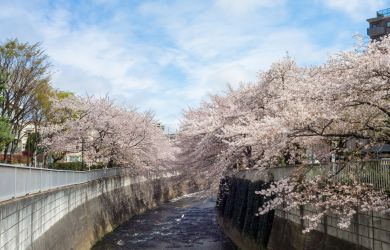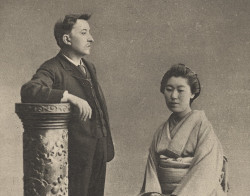
January 20, 2011
Monster Maker
All’s fair in blood and gore for special effects maestro Yoshihiro Nishimura
By Metropolis
Originally published on metropolis.co.jp on January 2011

Portrait by Benjamin Parks
A few blocks from the Ground Self Defense Force camp in Nerima, we are met by a man sporting a neatly trimmed goatee, well-worn work boots and black mechanic’s overalls. “It’s just through here,” he says, leading us under a garage door. We enter a room lined with steel shelves filled with body parts—a rack of human heads, a box of severed feet. Glancing up, we notice entire bodies hanging from the rafters.
But we aren’t scared in the slightest. Our host is not a deranged serial killer, but Japan’s most sought-after special effects artist.
Entering Yoshihiro Nishimura’s workshop is like stepping into one man’s nightmare—or should we say, his fantasy land. Miniature arms grow out of human heads, pointing space pistols in all directions. Amputated limbs segue into chainsaws and machine guns. Human flesh merges with machine.
This private world is becoming increasingly public as Nishimura’s films gain a devoted international following. Love them or hate them, Japanese “action gore” movies, the genre Nishimura helped found, are becoming one of Japan’s hottest exports.
A brief scene from Nishimura’s 2008 directorial debut, Tokyo Gore Police, offers a glimpse into the twisted world of his movies. A beautiful undercover policewoman (former Benetton model Eihi Shiina) is riding a packed Tokyo commuter train dressed in a kimono-print blouse and leather shorts. When a chikan fondles her rear, she grabs his wrists and drags him from the train to a secluded area as he whimpers his apologies. She coldly informs him that he has committed a crime, draws a samurai sword, and chops off the offending hands, shielding herself from the spray of blood with a traditional Japanese parasol.

©2008 Pony Canyon. All rights reserved
The scene is horrific, to be sure, but it is also carefully framed and abstractly beautiful, and even becomes humorous due to the sheer volume of obviously fake blood. (Like everyone in Nishimura’s films, the train molester seems to have extremely high blood pressure.) The arterial spray effect, achieved with a German-made pump originally designed for washing cars, has become a signature of sorts for Nishimura, prompting one YouTube user to comment on the trailer: “How much blood does this man think is in a human body, anyway?”
Tokyo Gore Police is actually a remake of Nishimura’s very first work, Anatomia Extinction, a short film made with a volunteer cast and crew in 1995. “At that time, Japanese train and telephone companies were all undergoing privatization,” Nishimura recalls, as he settles in for our interview in his work studio. “I wondered what would happen if the police also became a privatized company, doing their work with financial interests in mind. That idea served as the basis for the story.” The no-budget film won a special jury prize at the Yubari Fantastic Film Festival, which started as a project to revitalize a sleepy Hokkaido mining town but quickly became an internationally recognized barometer of the film world, and destination for high-profile visitors such as Quentin Tarantino.
Nishimura, who was mainly interested in becoming a director, handled the effects on his first film simply for economic reasons. But after the success of the short, he found himself deluged with requests from other filmmakers, including Suicide Club director Sion Sono. “At that time, there was no information or knowledge about these techniques in Japan,” Nishimura says. “I ordered Fangoria magazine and books by Tom Savini from overseas and would try to do what I could with the materials I could find in Japan.” Today Nishimura is called “the Tom Savini of Japan,” a reference to the man who created Jason Voorhees and George Romero’s zombies. He couldn’t be prouder of the nickname.
After acting as special effects supervisor on a long string of films, Nishimura reached a turning point in 2005. While many Japanese filmmakers struggle to find overseas distribution for their work, New York-based company Media Blasters approached Nishimura and frequent collaborator Noboru Iguchi and practically begged them to make a movie. “They told us that we could make whatever kind of story we wanted, just as long as we didn’t show the killing of children or animals. No Japanese filmmakers have ever had that kind of freedom, so we took advantage of it and I think we changed the course of Japanese film to some degree.”

©2008 Nikkatsu. All rights Reserved
The result was The Machine Girl, the story of a high school student hunting down the bullies who killed her brother, replacing the arm she loses along the way with a high-powered machine gun. The film enjoyed instant cult success in the US, and Media Blasters soon offered Nishimura the chance to direct, leading to Tokyo Gore Police, a low-budget but ambitious sci-fi thriller set in a dystopian near-future Japan. This was followed by Vampire Girl vs. Frankenstein Girl, the tale of a high school love triangle whose plot is pretty much summed up by the title. Nishimura’s latest directorial effort is this summer’s Helldriver, an apocalyptic thriller that involves half of Japan’s population turning into zombies who are kept behind a wall, and a young woman on a mission to the other side.
Special effects are an essential element in Nishimura’s films. Vampire Girl, for example, clocks in at under 90 minutes, but features over 320 separate effects shots. Yet the director has also developed a knack for handling actors thanks to observing so many other directors at work. Helldriver stars fashion model and Tokyo Girls Collection regular Yumiko Hara. “Of course, just walking down a runway and acting in a movie scene are very different,” the first-time actress says. “Nishimura was very aware of that and helped me understand my scenes.”
The director has also acquired a reputation for working fast and cheap. Despite having hundreds of zombie extras, Helldriver was shot in a scant two weeks for a budget of around $200,000—less than 1 percent of what it cost to make the 2004 American film Dawn of the Dead. “I draw every single shot in every film,” Nishimura explains. “I did over 6,500 drawings for this film, so when we go to the set, we know exactly what we have to get in the can that day. Because of our limited budgets, there are things that they do in Hollywood that we can never do. But on the other hand, we think of ways of doing things that would never occur to them.”
Although his audience is growing both at home and overseas, Nishimura is aware that not everyone is a fan. “After serial killer Tsutomu Miyazaki was caught and slasher films found in his house in the late ’80s, it became fashionable for authority figures to say that watching horror movies causes fans to go out and kill people,” he explains with a sigh. “But I have been to showings of my films overseas with 2,000 people in the audience. If you gather them together after the movie and say, ‘Let’s all go out and kill someone,’ there is no way they would go along with you. They know it is only entertainment. You would be more likely to find a violent crowd at a sporting event.”
PICK OF THE LITTER

© 2010 SUSHI TYPHOON/ NIKKATSU
Metropolis asked Nishimura to name the films everyone needs to see to understand the current state of Japanese cinema. This is what he had to say.
The Machine Girl was an important film because it was sort of like a compilation of ideas between myself and the director Noboru Iguchi. Everything we were interested in doing, we put into that film.
Suicide Club is a film Sion Sono made by putting in his own ideas, not just thinking about entertaining the audience, and that makes it unique.
Yuji Shimomura’s Death Trance is a great film with an interesting view of the world.
Mutant Girls Squad is an omnibus film. I directed a splatter segment, Tak Sakaguchi did an action segment, and Noboru Iguchi did a segment that is just weird, so you can learn about a lot of genres from that one film.
DVD LIBRARY
A selection of the 80-plus films featuring Nishimura’s special effects
Rubber’s Lover (1996)
 This low-budget black-and-white horror film about a group of mad scientists performing experiments on human subjects helped establish the look of the cyberpunk movement. Directed by Shozin Fukui.
This low-budget black-and-white horror film about a group of mad scientists performing experiments on human subjects helped establish the look of the cyberpunk movement. Directed by Shozin Fukui.
Meatball Machine (2005)
 A lonely factory worker and the girl he loves are turned into bio-mechanical monsters by alien parasites and forced into a gory showdown. Directed by Yudai Yamaguchi and Junichi Yamamoto.
A lonely factory worker and the girl he loves are turned into bio-mechanical monsters by alien parasites and forced into a gory showdown. Directed by Yudai Yamaguchi and Junichi Yamamoto.
Samurai Princess (2009)
 In this alternate history of feudal Japan, humans live alongside highly advanced mechanized dolls, including a female ninja created by a mad scientist. Directed by Kengo Kaji.
In this alternate history of feudal Japan, humans live alongside highly advanced mechanized dolls, including a female ninja created by a mad scientist. Directed by Kengo Kaji.
Gothic & Lolita Psycho (2010)
 Yuki (Rina Akiyama) ditches her good-girl wardrobe, dons gothic apparel, arms herself with a bullet-proof parasol and hunts down the demon-worshipping gang that killed her mother. Directed by Go Ohara.
Yuki (Rina Akiyama) ditches her good-girl wardrobe, dons gothic apparel, arms herself with a bullet-proof parasol and hunts down the demon-worshipping gang that killed her mother. Directed by Go Ohara.
Horny House of Horror (2010)
 A group of buddies discover a sex parlor with unbelievably low prices and beautiful staff (including AV star Saori Hara). It seems too good to be true. It is. Directed by Jun Tsugita.
A group of buddies discover a sex parlor with unbelievably low prices and beautiful staff (including AV star Saori Hara). It seems too good to be true. It is. Directed by Jun Tsugita.







